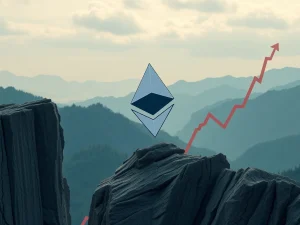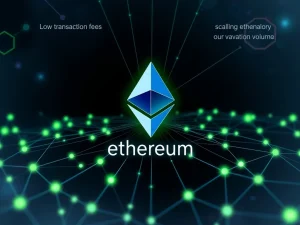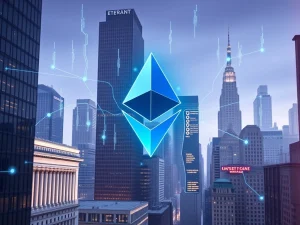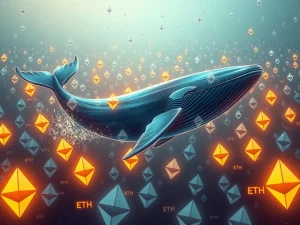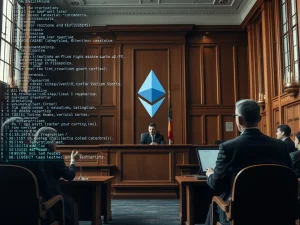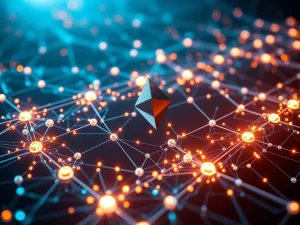Massive Ethereum Gas Limit Boost Proposed for Fusaka Hard Fork

Exciting news for anyone following the progress of the Ethereum network! Ethereum developers are exploring a significant change that could dramatically impact transaction costs and network capacity: a potential four times increase in the network’s gas limit as part of the upcoming Fusaka hard fork.
Understanding the Ethereum Gas Limit Proposal
What exactly is the Ethereum gas limit, and why is changing it such a big deal? Think of the gas limit as the maximum amount of ‘fuel’ a single block on the Ethereum network can consume. This fuel is used to execute transactions and smart contracts. A higher gas limit means more operations, or more complex operations, can fit into a single block, potentially leading to higher throughput and, crucially, lower average transaction fees during periods of high network activity.
Currently, the average gas limit sits just under 36 million, following a validator-supported increase on February 4th. However, core developers are now floating the idea of a much larger jump, proposing to test a raise to a staggering 150 million gas per block. This ambitious target is outlined in EIP 9678, introduced by Sophia Gold from the Ethereum Foundation’s protocol support team on April 23rd.
Why Ethereum Developers Want a Higher Limit
The primary motivation behind this potential increase is straightforward: scaling layer 1 execution. While layer 2 solutions are crucial for Ethereum’s long-term scaling vision, improving the base layer’s capacity remains a key goal. Developers believe that a significant gas limit increase could be achieved without adding complex new features, offering a relatively direct path to boosting the network’s ability to handle more activity.
During recent All Core Devs Execution (ACDE) meetings, this potential increase was discussed as a ‘key feature’ for Fusaka, the hard fork planned to follow the upcoming Pectra upgrade (expected around May 2024). Ethereum core developer Tim Beiko highlighted that while validators ultimately control the gas limit, an EIP is needed to coordinate client defaults and ensure this scaling effort remains a priority leading up to Fusaka, which might go live in late 2025.
Challenges and Coordination for the Fusaka Hard Fork
Implementing such a significant change isn’t without its challenges. A four times increase isn’t simply flipping a switch. Running the network at much higher gas limits than currently used on mainnet is expected to reveal bugs or performance issues in client software. This requires substantial effort from client developers for testing and fixing any problems that arise. Including the proposal as an EIP in the Fusaka hard fork timeline signals a commitment to dedicating the necessary resources to this work.
Coordination is paramount. As Tim Beiko noted, while validators decide the final limit, having EIP 9678 helps ensure all client teams are aligned and update their default settings in time for Fusaka’s potential deployment. This collaborative approach is essential for a smooth transition and network stability at higher capacities.
What This Means for the Ethereum Ecosystem
A successful increase in the Ethereum gas limit could have several positive impacts:
- Potentially Lower Fees: With more transaction capacity per block, the competition for block space could decrease, leading to lower gas prices, especially during peak demand.
- Increased Throughput: The network could process more transactions and complex smart contract interactions within the same timeframe.
- Enhanced L1 Utility: More complex decentralized applications (dApps) or operations might become economically viable directly on layer 1.
However, there are also considerations:
- Node Requirements: Running an Ethereum node at a significantly higher gas limit requires more processing power, bandwidth, and storage. This could potentially increase the barrier to entry for running full nodes.
- Network Stability: Operating at untested higher limits carries risks of discovering new vulnerabilities or performance bottlenecks.
The developers are aware of these trade-offs and are planning extensive testing to mitigate potential issues before the Ethereum upgrade goes live.
EIP 9678: The Blueprint for Higher Capacity
EIP 9678 serves as the formal proposal and coordination mechanism for this ambitious goal. It outlines the intention to raise the default gas limit and signals to the ecosystem that this is a priority for the post-Pectra development cycle. While the final decision on the exact limit rests with the validators who vote on it, the EIP provides a clear target and framework for client developers to work towards. This structured approach ensures that necessary changes and testing are integrated into the hard fork development process.
Conclusion: A Bold Step Towards Ethereum Scaling
The discussion around a potential 4x increase in the Ethereum gas limit is a testament to the network’s ongoing evolution and the developers’ commitment to scaling its layer 1 capabilities. While challenges remain, particularly in rigorous client testing and ensuring network stability, the prospect of significantly boosting throughput and potentially reducing transaction costs is a major development for the ecosystem. As the Pectra upgrade approaches and the focus shifts towards the Fusaka hard fork, the progress on this gas limit proposal will be a key area to watch for anyone invested in the future of Ethereum.

